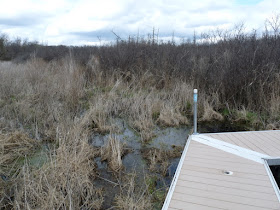The Volo Bog State Natural Area, or Volo Bog as it is called, encompasses nearly 1200 acres in the northeast corner of Illinois.
Originally part of an old farm, the very nice Visitor Center is housed in the old dairy barn.
It is the only quaking mat bog in Illinois to exhibit all stages of zonal plant succession, including an open water center. This uniqueness enabled it to be registered as a National Natural Landmark in 1973.
These trees and shrubs mark the edge of the old glacial lake.
A half-mile boardwalk trail takes you through the marsh moat and each zone, giving you a close view of a glacial bog.
As the marsh ends, one enters the Tall Shrub Zone, easily seen in the pictures above and below.
Further along, one comes to a floating mat of live tamarack trees.
This is the tamarack zone, where sphagnum moss carpets the ground.
More than 20 species of threatened and endangered plants and animals include plants typically found much farther north in the boglands of Minnesota and Canada.
The leaves of the endangered pitcher plant are shaped like cups to hold water, which lures insects down inside.
They are then trapped by the slippery leaf surface and the down-pointing hairs inside.
At the bog center, this small pond is all that remains of the old kettle hole lake that once covered about 50 acres.
A thin herb mat floats along the edges--
--thickening as it progresses away from the center, grading into the low shrub zone and then the tamarack forest beyond.
Above is the thin herb mat floating along the pond edge.
Below is sphagnum moss found in the tamarack zone.
As the Wisconsin glacier receded from northeastern Illinois about 1200 years ago, lakes, bogs, marshes, and other wetlands formed in the depressions called kettle-holes. Today, Volo Bog is the only such peat-land in Illinois still to have an open water center.
Based on recent changes in scientific terminology, Volo Bog is not really a bog, it is a fen. A bog receives water from precipitation only, and since Volo Bog receives its water from ground water and runoff, it is a fen.
For more information on the Volo Bog go to: http://www.Volo Bog.com.
























I love the Volo Bog it is pretty neat there.
ReplyDelete